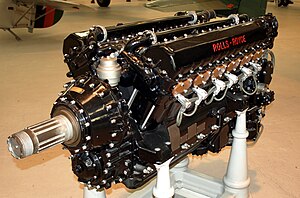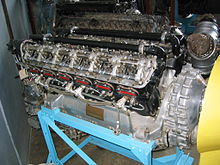avia.wikisort.org - Engine
The Kestrel or type F is a 21 litre (1,300 in³) 700 horsepower (520 kW) class V-12 aircraft engine from Rolls-Royce, their first cast-block engine and the pattern for most of their future piston-engine designs.[1] Used during the interwar period, it provided excellent service on a number of British fighters and bombers of the era, such as the Hawker Fury and Hawker Hart family, and the Handley Page Heyford. The engine also sold to international air forces, and it was even used to power prototypes of German military aircraft types that were later used during the Battle of Britain. Several Kestrel engines remain airworthy today.
| Kestrel | |
|---|---|
 | |
| Rolls-Royce Kestrel XVI at the Royal Air Force Museum Cosford | |
| Type | Piston V-12 aero engine |
| Manufacturer | Rolls-Royce Limited |
| First run | Late 1926 |
| Major applications | Hawker Hart Miles Master |
| Number built | 4,750 |
| Developed into | Rolls-Royce Goshawk Rolls-Royce Peregrine |
Design and development
Origin
The Kestrel came about as a result of the excellent Curtiss D-12, one of the first truly successful cast-block engines. Earlier designs had used individually machined steel cylinders that were screwed onto a crankcase, whereas the cast-block design used a single block of aluminium that was machined to form cylinders. The result was both simpler to build as well as lighter and much stronger, requiring only an investment in new machining equipment.[2]
The D-12 was one of the most powerful engines of its era, and continued to exchange records with other contemporary high-power engines. No British company could offer anything like it, and when Fairey imported 50 of the type (renaming them as the Fairey Felix) the Air Ministry had enough and ordered Napier and Rolls-Royce to start work on cast-block engines of their own.
Arthur Rowledge, one of Napier's chief engineers and the designer of the Napier Lion engine, became fed up with management and left for Rolls.[3] In this one move any Napier design effort ended while Rolls' received a boost. Applying every known advance since the D-12 was introduced, Rowledge designed the new engine to use supercharging at all altitudes, allowing it to outperform naturally aspirated engines by as much as they were willing to increase the boost pressure.
Cooling system
One key advance in the Kestrel was the use of a pressurised cooling system. Water boils at 100 °C at standard atmospheric pressure, but this temperature decreases with altitude. Since the amount of heat carried out of the engine is a function of maximum coolant temperature and volume, and the coolant has to be kept below boiling point, an increasing amount of fluid had to be used, along with an increasingly large radiator to cool it. The solution was to pressurise the entire cooling system, thereby raising the temperature at which it boils: not only does this prevent the decrease in cooling performance with altitude, it also increases the boiling point even at ground level. The Kestrel was built to maintain enough pressure to keep the boiling point at about 150 °C.[4]
Improvements

The engine was first produced in 1927 at 450 hp (340 kW), which soon improved in the IB version to 525 hp (390 kW). This variant saw widespread use in the Hawker Hart family that was the mainstay of British air power during the early 1930s. However, it was not long before power output was increased dramatically; the V model provided 695 hp (520 kW) at 3,000 rpm with no basic change to the design, while the XVI used in the Miles Master delivered 670 hp (500 kW).
Messerschmitt also tested its first Messerschmitt Bf 109 V1 prototype, bearing German civilian registration D-IABI, with a Kestrel engine in 1935 as the German-designed intended engines were not yet ready. Junkers also used a Kestrel for the first prototype of the Ju 87 "Stuka" dive bomber. The Reich Air Ministry (RLM) acquired four Kestrel VI engines by trading Rolls-Royce a Heinkel He 70 Blitz as an engine testbed.[5]
Increased availability of higher octane aviation fuels in the late 1930s allowed the engine to be boosted to higher power levels without suffering from detonation, and the Kestrel eventually attained a power output of 720 hp (537 kW) in the XXX variant of 1940.[6]
Further developments of the Kestrel were the Goshawk and the Peregrine (and therefore the Vulture). In practice, development of the Peregrine and Vulture was troubled, and they were both cancelled with comparatively few built.
Variants
The Kestrel was produced in 40 distinct variants which can be divided into three main groups: normally aspirated, medium supercharged, and fully supercharged. One variant, the Kestrel VIII, was configured as a 'pusher engine' for the Short Singapore flying boat. Apart from supercharging, the variant differences centred on varying compression ratios and propeller reduction gearing.[7]
Applications
From Lumsden, the Kestrel may not be the main powerplant for these types.
- Aircraft applications

- Airco DH.9
- Avro Antelope
- Blackburn Nautilus
- Blackburn Sydney
- Dornier Do J
- Fairey Firefly II
- Fairey Fleetwing
- Fairey Fox
- Fairey Hendon
- Fairey S.9/30[8]
- Fokker C.V
- Fokker C.X (prototype)
- Fokker D.XVII
- Gloster Gnatsnapper
- Gloster TC.33[9]
- Gloster TSR.38
- Handley Page Hamilton
- Handley Page Heyford
- Handley Page H.P.30
- Hawker Audax
- Hawker Demon
- Hawker Fury
- Hawker Hardy
- Hawker Hart
- Hawker Hind
- Hawker Hornet
- Hawker Nimrod
- Hawker Osprey
- Heinkel He 70 G-1
- Heinkel He 112 (prototype)
- Henschel Hs 122 (prototype)
- Junkers Ju 86 (intended)
- Junkers Ju 87 (prototype)
- Messerschmitt Bf 109 (prototype)
- Miles Master
- Miles Kestrel
- Parnall Pipit
- Praga E-45[10]
- Renard R.31
- Saro A.10
- Short Gurnard
- Short Singapore
- Supermarine Scapa
- Supermarine Southampton
- Vickers F.21/26
- Vickers Type 150
- Vickers Type 163
- Westland Wizard
- Other applications
Survivors
Several Rolls-Royce Kestrel engines remain in service, powering restored Hawker biplane types:
- A Hawker Hind is owned and operated by the Shuttleworth Collection and flies regularly throughout the summer months.
- A privately owned Hawker Demon resides with the Shuttleworth Collection and is the last remaining airworthy example of the type.
- A Hawker Nimrod I, S1581, resides at Duxford with The Fighter Collection. Each aircraft is fitted with a Rolls-Royce Kestrel V.
- A Hawker Nimrod II, K3661, resides at Duxford with the Historic Aircraft Collection and is fitted with a Rolls-Royce Kestrel VI[11]
Engines on display
Preserved examples of the Rolls-Royce Kestrel engine are on public display at the:
- Australian National Aviation Museum
- Brooklands Museum
- Imperial War Museum Duxford
- Polish Aviation Museum Cracow
- Rolls-Royce Heritage Trust
- Royal Air Force Museum Cosford
- Royal Air Force Museum London
- Science Museum (London)
- World of Wearable Arts and Classic Cars Museum (Nelson, NZ)
- South Australian Aviation Museum Adelaide (Operational exhibit)
Specifications (Kestrel V)

Data from Lumsden[12]
General characteristics
- Type: Supercharged liquid-cooled 60-degree V12 engine
- Bore: 5 in (127 mm)
- Stroke: 5.5 in (140 mm)
- Displacement: 1,295.88 in³ (21.24 L)
- Length: 74.61 in (1,895 mm)
- Width: 24.41 in (620 mm)
- Height: 35.63 in (905 mm)
- Dry weight: 957 lb (434 kg)
Components
- Valvetrain: Single overhead camshaft driving two inlet and two exhaust poppet valves per cylinder
- Supercharger: Gear-driven centrifugal type supercharger
- Fuel system: Rolls-Royce carburettor
- Fuel type: 87 octane petrol
- Cooling system: Liquid-cooled, pressurised to 300°F (150°C)
- Reduction gear: Spur, 0.553:1
Performance
- Power output:
- 685 hp (511 kW) at 2,240 rpm for takeoff
- 631 hp (471 kW) at 2,900 rpm at 14,400 ft (4,400 m)
- Specific power: 0.53 hp/in³ (24.05 kW/L)
- Compression ratio: 6.0:1
- Oil consumption: 0.18-0.35 oz/(hp/hr) (7-13 g/(kW/hr))
- Power-to-weight ratio: 0.72 hp/lb (1.18 kW/kg)
See also
Related development
Comparable engines
Related lists
References
Notes
- Lumsden 2003, p.190.
- Rubbra 1990, p.19.
- Lumsden 2003, p.164.
- Rubbra 1990, p.43.
- This aircraft was instrumental in testing the Rolls-Royce PV-12, later to become the Rolls-Royce Merlin.
- Lumsden 2003, p.196.
- Lumsden 2003, pp.190-197.
- Taylor 1974 p.232
- James 1971 p.203
- Grey 1972, p. 96c
- The Shuttleworth Collection - Hawker Demon
- Lumsden 2003, p.195.
Bibliography
- Erfurth, Helmut. Junkers Ju 87 (Black Cross Volume 5). Bonn, Germany: Bernard & Graefe Verlag, 2004. ISBN 1-85780-186-5.
- Grey, C.G. (1972). Jane's All the World's Aircraft 1938. London: David & Charles. ISBN 0-7153-5734-4.
- Lumsden, Alec. British Piston Engines and their Aircraft. Marlborough, Wiltshire: Airlife Publishing, 2003. ISBN 1-85310-294-6.
- Rubbra, A.A.Rolls-Royce Piston Aero Engines - A Designer Remembers. Rolls-Royce Heritage Trust. Historical Series no 16. 1990. ISBN 1-872922-00-7
- Taylor, H.O. (1974). Fairey Aircraft since 1915. London: Putnam Publishing. ISBN 0-370-00065-X.
- James, Derek N. (1971). Gloster Aircraft since 1917. London: Putnam Publishing. ISBN 0-370-00084-6.
Further reading
- Gunston, Bill. Development of Piston Aero Engines. Cambridge, England. Patrick Stephens Limited, 2006. ISBN 0-7509-4478-1
External links
На других языках
[de] Rolls-Royce Kestrel
Der Rolls-Royce Kestrel war ein wassergekühlter Zwölfzylinder-V-Flugmotor in stehender Anordnung (Kurbelwelle unten) des britischen Herstellers Rolls-Royce. Der Kestrel hatte als erster Rolls-Royce-Motor ein Kurbelgehäuse (Motorblock) aus einer Aluminiumlegierung anstelle von Grauguss.- [en] Rolls-Royce Kestrel
[es] Rolls-Royce Kestrel
El Kestrel o tipo F es un motor aeronáutico de 12 cilindros en V de 520 kW (700 hp) de la compañía Rolls Royce, su primer motor de bloque de fundición y la base para muchos de sus futuros diseños de motores de pistones.[1] Usado en el periodo de entreguerras, su historia sigue siendo algo oscura, a pesar de que prestó un excelente servicio en varios aviones caza de la época.[fr] Rolls-Royce Kestrel
Le Kestrel ou type F est un moteur d'avions de l'entre-deux-guerres, conçu et fabriqué par la firme britannique Rolls-Royce. Il s'agit du premier moteur à bancs de cylindres monobloc du motoriste, et il préfigure le style de la plupart de ses futurs modèles de moteurs à pistons[1]. Il demeure quelque peu méconnu, mais il eut d'excellents états de service sur un certain nombre de chasseurs britanniques de l'époque.[it] Rolls-Royce Kestrel
Il Rolls-Royce Kestrel (gheppio in lingua inglese), o type F, fu un motore aeronautico dodici cilindri a V sviluppato dall'azienda britannica Rolls-Royce Limited nei tardi anni venti, prodotto per tutto il decennio successivo e utilizzato da numerosi velivoli nel periodo interbellico prima dell'inizio della seconda guerra mondiale.[ru] Rolls-Royce Kestrel
Роллс-Ройс Кестрел (англ. Rolls-Royce Kestrel) или тип F – 12-цилиндровый авиационный двигатель фирмы Роллс-Ройс. Своё название, в соответствии с принятой на фирме системой наименований, двигатель получил в честь пустельги — мелкого хищника семейства соколиных. Kestrel стал первым двигателем этой фирмы с литым блоком цилиндров и во многом задал тенденции, получившие развитие в позднейших её разработках[1]. Поскольку Kestrel использовался в межвоенный период, он остался относительно малоизвестным, хотя успел прекрасно послужить на множестве британских самолётов той эпохи. Двигатель также поставлялся за рубеж и даже устанавливался на прототипы немецких боевых самолётов, позже принимавших участие в Битве за Британию. Несколько двигателей Kestrel остаются пригодными к лётной эксплуатации и сегодня.Другой контент может иметь иную лицензию. Перед использованием материалов сайта WikiSort.org внимательно изучите правила лицензирования конкретных элементов наполнения сайта.
WikiSort.org - проект по пересортировке и дополнению контента Википедии